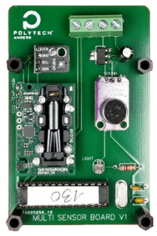- Index
- >Projects
- >Past projects
- >Building Internet of Things
BIoT - Building Internet of Things - Research Project
Optimisation and predictive control of the performance of intelligent buildings based on usage
Group : Reliability Engineering and Decision-Making tools
Labelling: none
Duration: 3 years (01/01/2020 - 12/31/2022)
Funding: RFI WiSE
Staff involved from LARIS: Marie-Lise Pannier, David Bigaud, Chuhao Jiang (PhD student)
Project partners: Alain Godon (Polytech Angers)
Context
The technical dimension is no longer the only indicator of the building performance during its use phase. Building Management Systems (BMS) have already been integrated in buildings, but a new vision is required to redefine the building performance. The concept of Smart Building relies on this new vision, and does not only cover the building technical dimensions but also the human dimension, including all building actors and occupants.
In addition, the concept of Cognitive Building Management (CBM) is a promising application field of Internet of Things (IoT). A building will be equipped with sensing and actuating devices to monitor it (e.g. windows opening, indoor air quality, user presence, position), to predict the energy loads and to measure real-time energy consumptions. All data collected by sensors must then be analysed using specific algorithms in order to improve the user experience and comfort, to optimise the building management and to reduce costs.
Issues

The BIoT (Building Internet of Things) project, funded by the RFI WiSE in the framework of its Attractivity call for proposal, will integrate four main topics: the development of cognitive (and statistical) models of occupancy, the modelling of occupancy and uses based on machine learning techniques, the simulation and optimisation of building performance, and the control of the building systems and components using predictive control model..
BIoT will mainly focus on the aspects associated with occupancy modelling by learning techniques (e.g. multi-agent models and reinforcement learning) and on predictive models of optimal control.
- Stochastic and robust modelling of the occupancy and the building use, using deep learning methods: although an increasing number of studies are carried out on user behaviour, the role of the occupants remains rarely considered during the building operation phase. This can be explained by the lack of available models to represent occupancy in a realistic way. The identified occupancy patterns are often insufficiently dynamic (e.g. the patterns often have temporal dynamics, but not spatial dynamics). While this problem can easily be solved for residential buildings with a small number of occupants and building zones, it is more difficult to solve for more complex buildings with different uses and where different profiles meet and may interact.
Occupancy scenarios are highly dependant of season, weather, time of the day, user preferences, individual and collective behaviours (e.g. single person or family in residential buildings, individual office or open-spaces in office building)… Consequently, stochastic models (e.g. Markov chains) should be used to create realistic scenarios taking the temporal variability into account. In the project, machine learning methods or reinforcement methods will be applied to get more robust occupation model, able to take into account uncertainties. The LARIS laboratory has expertise in the use and development of machine and deep learning methods such as decision trees, artificial neural networks, or Bayesian network (which have recently been applied in order to identify deviations in the building performance). We wish to explore the concept of multi-agent modeling, which is new for the laboratory, in order to predict occupants’ behaviour as well as their habits and preference in terms of thermal, air, visual and acoustic comfort.
The occupancy and use model will be implemented in a digital twin of a building, coupled to building dynamic energy simulations, in order to accurately calibrate the energy model and provide a more precise basis for the optimisation studies. The models will also be used in the digital twin for real-time monitoring and control of building energy systems.
- Control of the building systems using a predictive control model: the second topic of BIoT is the user-centric control of the building systems. Occupants play an important role in the building performance and have strong interactions with the building. Therefore, their needs and actions must be taken into account and the user-centric approach seems to be a viable alternative to an automated control approach. After performing learning technique on previous observations, users' behaviours and habits are well known and the building's technical equipment (HVAC, lighting, blinds, …) can be control in real time, (depending on these known users' preferences), using a set of sensing and actuating devices.
Two research themes are linked with the user-centric control. The first one concerns the definition of optimal control strategies, according to the occupants’ activities, and their application to the building in real time. The second theme concerns the predictive control model based on the occupant’s habits, predicted weather data and the building dynamics to predefine the next optimal strategy.


